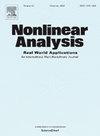具有间接掠食性的捕食系统的全局适定性和空间非齐次Hopf分岔
IF 1.8
3区 数学
Q1 MATHEMATICS, APPLIED
引用次数: 0
摘要
本文探讨了一个捕食者-猎物系统,该系统具有间接捕食者-趋近性,其中猎物表现出由捕食者分泌的化学物质引发的排斥反应。我们首先建立了系统在任意空间维度上经典解的整体存在性和一致有界性,并假设函数响应g(u,v)是有界的。此外,在猎物种群密度二次衰减的假设下,我们在两个空间维度上证明了系统经典解的整体存在性和一致有界性,假设函数响应g(u,v)是次线性的。线性稳定性分析表明,间接捕食者趋向性在模式形成中起着至关重要的作用。对于Lotka-Volterra型泛函响应,我们通过构造适当的Lyapunov泛函证明了正常稳态的全局稳定性。相反,对于Beddington-DeAngelis函数响应,我们研究了具有间接捕食者趋向性的捕食者-食饵系统的Hopf分岔。为了计算这种分岔的范式,我们引入了一种将趋向性系数作为摄动参数的有效新算法。利用该算法分析了的士系数诱导的Hopf分岔的方向和稳定性。最后,进行了数值模拟来验证我们的分析结果。本文章由计算机程序翻译,如有差异,请以英文原文为准。
Global well-posedness and spatially inhomogeneous Hopf bifurcation in a predator-prey system with indirect predator-taxis
This paper explores a predator-prey system featuring indirect predator-taxis, where prey exhibit a repellent response triggered by chemicals secreted by predator. We first establish the global existence and uniform boundedness of classical solutions for the system in any spatial dimension, assuming that the functional response is bounded. Additionally, under the assumption of quadratic decay in the prey population density, we prove the global existence and uniform boundedness of classical solutions for the system in up to two spatial dimensions, assuming that the functional response is sublinear. Linear stability analysis reveals that indirect predator-taxis plays a crucial role in pattern formation. For the Lotka-Volterra type functional response, we demonstrate global stability of the positive constant steady state by constructing an appropriate Lyapunov functional. Conversely, for the Beddington-DeAngelis functional response, we investigate Hopf bifurcation in the predator-prey system with indirect predator-taxis. To compute the normal form of this bifurcation, we introduce an efficient new algorithm treating the taxis coefficient as a perturbation parameter. Using this algorithm, we analyze the direction and stability of taxis coefficient-induced Hopf bifurcation. Finally, numerical simulations are conducted to validate our analytical findings.
求助全文
通过发布文献求助,成功后即可免费获取论文全文。
去求助
来源期刊
CiteScore
3.80
自引率
5.00%
发文量
176
审稿时长
59 days
期刊介绍:
Nonlinear Analysis: Real World Applications welcomes all research articles of the highest quality with special emphasis on applying techniques of nonlinear analysis to model and to treat nonlinear phenomena with which nature confronts us. Coverage of applications includes any branch of science and technology such as solid and fluid mechanics, material science, mathematical biology and chemistry, control theory, and inverse problems.
The aim of Nonlinear Analysis: Real World Applications is to publish articles which are predominantly devoted to employing methods and techniques from analysis, including partial differential equations, functional analysis, dynamical systems and evolution equations, calculus of variations, and bifurcations theory.

 求助内容:
求助内容: 应助结果提醒方式:
应助结果提醒方式:


